It looks like you're using an Ad Blocker.
Please white-list or disable AboveTopSecret.com in your ad-blocking tool.
Thank you.
Some features of ATS will be disabled while you continue to use an ad-blocker.
share:
All Yesterdays: Unique and Speculative Views of Dinosaurs and Other Prehistoric Animals

io9.com...
www.amazon.com...
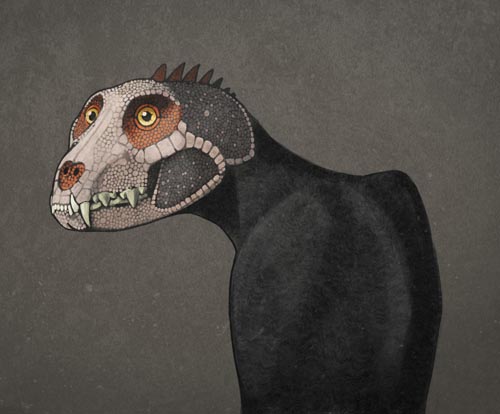
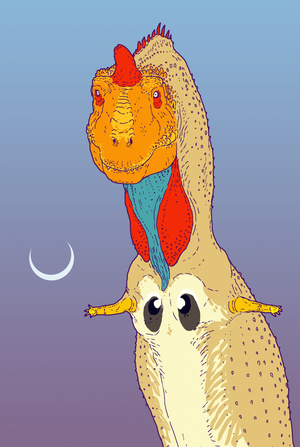

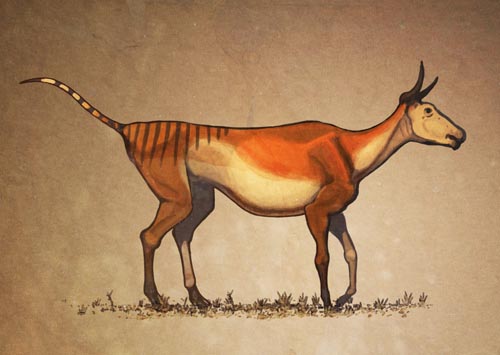
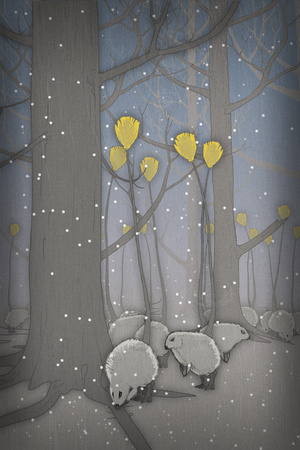
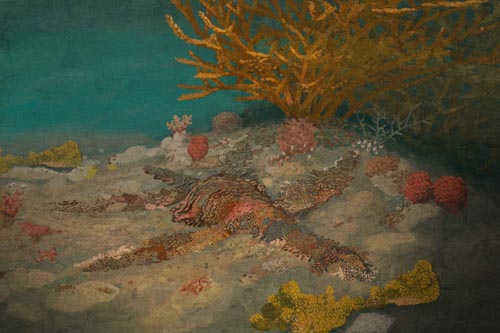
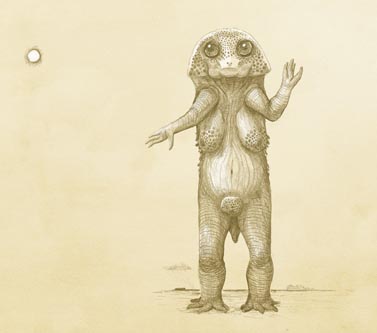
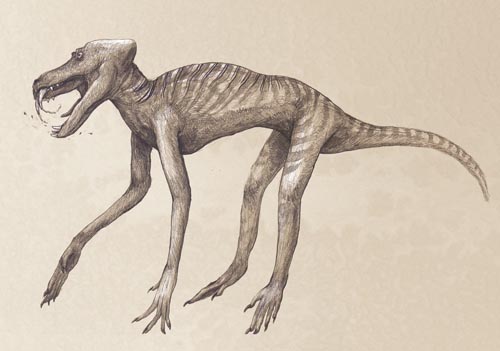
So this book is based off half science half imagination. But isn't that what all dinosaur re-creation art is? I found the drawings hmm interesting and entertaining to say the least.
They way they interpreted modern animals like the cow and baboon skeletons and how paleontologists would interpret them is genius. It makes you think..
When I look at my cockatiel see a little raptor, especially with those claws.

How did dinosaurs look? The only way any of us know is from looking at images created by paleoartists, people who specialize in imagining extinct creatures by studying their skeletons. The problem is that skeletons only tell us part of the story, revealing little about layers of body fat, skin type, coloration, and behavior. Now, a new book called All Yesterdays: Unique and Speculative Views of Dinosaurs and Other Prehistoric Animals — half science, half-science fiction — offers us a radical new way of looking at dinosaurs, based on contemporary scientific speculation. We have an incredible gallery of the paleoart from the book.
Written by paleoartists C.M. Kosemen and John Conway, with an introduction by renowned paleontologist Darren Naish, All Yesterdays is the kind of wonderful, provocative thought experiment that only exists at the nexus of science and art. The book corrects a lot of misconceptions from famous dinosaur art, such as work by Charles Knight, and then heads off into new speculations based on all the "unknown unknowns" of paleontological reconstruction.
io9.com...
www.amazon.com...

And here is a house cat, drawn by Conway channeling the dinosaur paleontologist. No creature could possibly have fur on its face, since dinosaurs don't. So this is clearly how a cat looked.

This is a Majungasaurus crenatissimus, by C.M. Kosemen. One of the points that Koseman and Conway make in the book is that there are certain stereotypical images we get of dinosaurs. We always see them in profile, because that's how skeletons look best. Here we see this fierce predator from the front, and get a good view of its crazy wattles.

These are proceratops, by John Conway. These are a small species related to Triceratops, and we know very little about how they acted. Kosemen and Conway point out that we should look to contemporary animal behavior for clues. They note that goats climb trees, even though their skeletons don't suggest tree climbing animals. Maybe proceratops was the same way?

Here is John Conway's representation of how our dinosaur paleontologist would draw a cow, based on its skeleton. Obviously it must have been a sleek, muscular animal!

This is a Leaellynasaura amicagraphica, by John Conway. This is an experiment with imagining an alternative to what these small dinosaurs might have looked like. The artists note that paleoartists always assume that dinosaurs were sleek, their bodies in the exact shape of their skeletons. But few animals today are shaped exactly like their skeletons. Maybe some dinos were fat with giant, tufted tails.

This is a plesiosaur, by John Conway. Here the artist is imagining this giant ocean predator in an atypical paleoart pose — it's hiding in the muck and algae near the shore, waiting for prey. It's very likely dinosaurs would have had camouflage, and therefore when we imagine them we should consider that their coloration might have matched the colors in their habitats.

This is a picture of the infamous Homo diluvii, by C.M. Kosemen. He and Conway share this as an example of how easy it is to "read into" a skeleton whatever you want. The Homo diluvii was something that 18th century scientists first sketched, as a way to explain the skeleton of a giant salamander they'd discovered (the fossil has since been properly identified). Because they couldn't believe a salamander could have been that big, they drew this humanoid and decided it was a radically new kind of human who had lived on Earth long ago. Kosemen and Conway hint that our current paleoart of dinosaurs might be just as laughable and mistaken as this Homo diluvii.

In the final section of All Yesterdays, we go into the realm of science fiction. An imaginary dinosaur paleontologist discovers ancient fossils from the late Quaternary and tries to sketch what they might have looked like. Here, Kosemen shows the way this dino paleontologist might reconstruct a baboon, by assuming that its body was in the exact shape of its skeleton and that it probably looked kind of like a reptile.
So this book is based off half science half imagination. But isn't that what all dinosaur re-creation art is? I found the drawings hmm interesting and entertaining to say the least.
They way they interpreted modern animals like the cow and baboon skeletons and how paleontologists would interpret them is genius. It makes you think..
When I look at my cockatiel see a little raptor, especially with those claws.
edit on 8-12-2012 by ShotGunRum because: (no reason given)
I really like this. It seems that paleontologists tend to make tremendous extrapolations from minimal information. They will find a single knuckle
bone and tell us the animals size, diet and how big a herd they ran in. Plus, I'm always a big fan of stating the alternative hypothesis instead of
the "one, true answer" so frequently reported in pop-sci articles.
They will find a single knuckle bone and tell us the animals size, diet and how big a herd they ran in.
Indeed. Not even an exaggeration. I always found it hard to picture how dinosaurs could look differently, sadly the textbook images have been etched into my mind.
Way cool! These are more like my imagination. Indeed our speculations on how they looked are getting out of date in my opinion. I really like how they
are imagined in these pictures.
You have sparked my imagination friend! I'm going to be looking more into ideas like this.
p.s. sorry for over using imagination lol. S & F!
You have sparked my imagination friend! I'm going to be looking more into ideas like this.
p.s. sorry for over using imagination lol. S & F!
edit on 12/7/2012 by mcx1942 because: forgot a word lol
Growing up I always questioned the standard model for what a dinosaur should look like .
Dinosaur feathers likely for sex not flying
fossilized feathers from 78million years ago photos
Funny how they can think of how a dinosaur should sound and they were all scaly and lizard like and they were so adamant that they had figured it all out .
Dinosaur feathers likely for sex not flying
fossilized feathers from 78million years ago photos
Sept. 15, 2011 -- A stunning array of prehistoric feathers, including dinosaur protofeathers, has been discovered in Late Cretaceous amber from Canada. The 78 to 79-million-year-old amber preserved the feathers in vivid detail, including some of their diverse colors. The collection, published in this week's Science, is among the first to reveal all major evolutionary stages of feather development in non-avian dinosaurs and birds.
Funny how they can think of how a dinosaur should sound and they were all scaly and lizard like and they were so adamant that they had figured it all out .
Wonderful post.
I love it.
thanks! S + F
I've often wondered how the dinosaurs might have actually appeared.
Looking at the skeleton of a Lion, you'd never guess at it's mane, nor the Leopard its spots, or the Tiger its stripes.
Getting closer to dinosaurs in looking at birds, the skeleton of a peacock won't give any indication of it's large fan tailed display, nor the skeleton of a turkey. The skeletons of Parrots, and the many different sorts of Birds of Paradise give no clue to their vibrant plumage either.
Perhaps the paleoartists should indeed take more cues from at least birds.
I love it.
thanks! S + F
I've often wondered how the dinosaurs might have actually appeared.
Looking at the skeleton of a Lion, you'd never guess at it's mane, nor the Leopard its spots, or the Tiger its stripes.
Getting closer to dinosaurs in looking at birds, the skeleton of a peacock won't give any indication of it's large fan tailed display, nor the skeleton of a turkey. The skeletons of Parrots, and the many different sorts of Birds of Paradise give no clue to their vibrant plumage either.
Perhaps the paleoartists should indeed take more cues from at least birds.
it is an interesting sensation, shocking even, to have my ignorance handed to me so swiftly. I certainly didn't expect it, coming into this thread.
the house-cat was a real "oh s###" moment.
my mind must be chock-full of such false premise.
the house-cat was a real "oh s###" moment.
my mind must be chock-full of such false premise.
reply to post by Druscilla
That's a good point. Dinosaurs could have been beautiful like the birds of paradise for all we know.
Getting closer to dinosaurs in looking at birds, the skeleton of a peacock won't give any indication of it's large fan tailed display, nor the skeleton of a turkey. The skeletons of Parrots, and the many different sorts of Birds of Paradise give no clue to their vibrant plumage either.
That's a good point. Dinosaurs could have been beautiful like the birds of paradise for all we know.
edit on 8-12-2012 by ShotGunRum because: (no reason given)
reply to post by Druscilla
Or just in the coloration of dinosaurs...
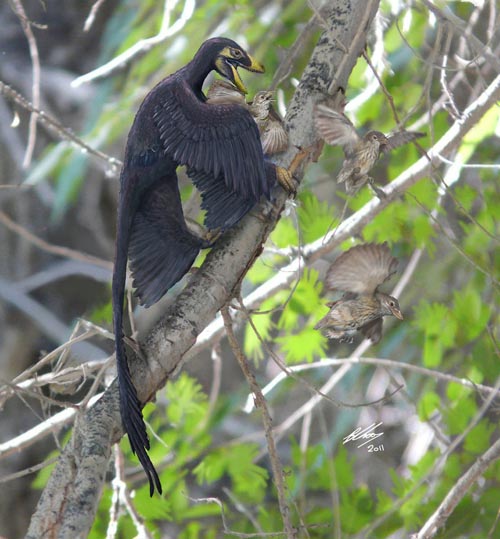
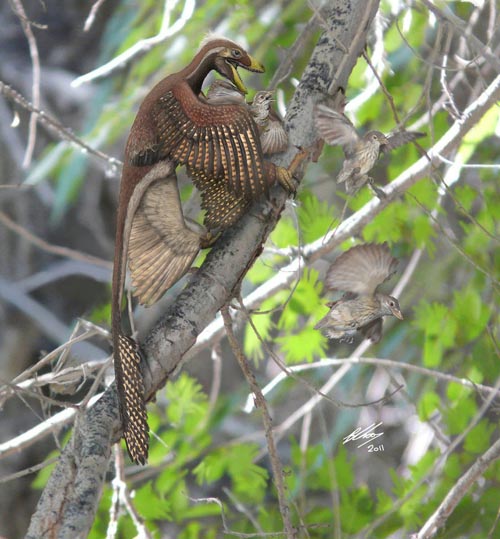
Source Image
Or just in the coloration of dinosaurs...


In the branches of a gingko, the 4-winged dromaeosaur Microraptor gui pounces on an enantiornithine bird (Sinornis santensis). Briefly losing balance as it clutches the screeching avian, the dinosaur feels around with it's clawed foot to gain a secure purchase before finishing off it's victim with a bite to the head.
A fossil skeleton of Microraptor (one half of which is right now sitting next to my aquarium across from my desk, the counterpart is on the windowsill) was described in 2011 showing the partially arcticulated remains of a tree-dwelling enantiornithine in it's tummy. This not only provided direct evidence of Micro's predatory habits, but was viewed as corroborating the idea of an arboreal lifestyle for this dinosaur.
Artwork originally published in: O’Connor, Zhou & Xu. 2011. Additional specimen of Microraptor provides unique evidence of dinosaurs preying on birds. PNAS
Source Image
edit on 8-12-2012 by ShotGunRum because: (no reason given)
The book looks rubbish. We know very well that most dinosaurs had reptile like skin, because we have their skin
it's true that we're making assumptions on what dinoasaurs may look and behave, but this is based on actual science. Far more likely than these made up creations from the book in question
it's true that we're making assumptions on what dinoasaurs may look and behave, but this is based on actual science. Far more likely than these made up creations from the book in question
I was thinking about this the other day...there is so much speculation about so many things from our past that is accepted for truth, the dinosaurs
are just one of them. Interesting pictures. My son loves dinosaurs and what he has been taught in school is completely subjective, yet they give
tests on these subjects, furthering the belief that they are rooted in fact. They should have a disclaimer on everything taught.
reply to post by GrandStrategy
What you know is what you have been taught, it does not make it fact.
What you know is what you have been taught, it does not make it fact.
reply to post by Truekn
Actually this is quite possible. In my wildlife management course, part of our field exam was to take a single tooth and determine exactly those things, as well as, the habitat and rearing habits of the species. These were for living animals though. I do agree that determining the appearance would be tough though, just from some bones.
They will find a single knuckle bone and tell us the animals size, diet and how big a herd they ran in.
Actually this is quite possible. In my wildlife management course, part of our field exam was to take a single tooth and determine exactly those things, as well as, the habitat and rearing habits of the species. These were for living animals though. I do agree that determining the appearance would be tough though, just from some bones.
edit on 8-12-2012 by dug88 because: (no reason given)
Originally posted by BrokenAngelWings33
reply to post by GrandStrategy
What you know is what you have been taught, it does not make it fact.
No, the fact that what I said is a fact is what makes it so.
The book in question is nonsense. It's nothing but unscientific artist renditions.
And I haven't been "taught" anything, that type of language implies I've been lectured to and told. My understanding of what dinosaurs most likely looked like is based on my own research of the facts.
If you think dinosaurs were running about with fur, when it's proven from skin samples that they weren't, then that's your problem
some of you on ats are too paranoid for your own good.
reply to post by GrandStrategy
Well they didn't find non-avian dinosaur feathers until the 1990's. So we don't know everything.
Dinosaurs could have had feathers that resembled fur, like on this bird. You're being a little too closed minded, I think.
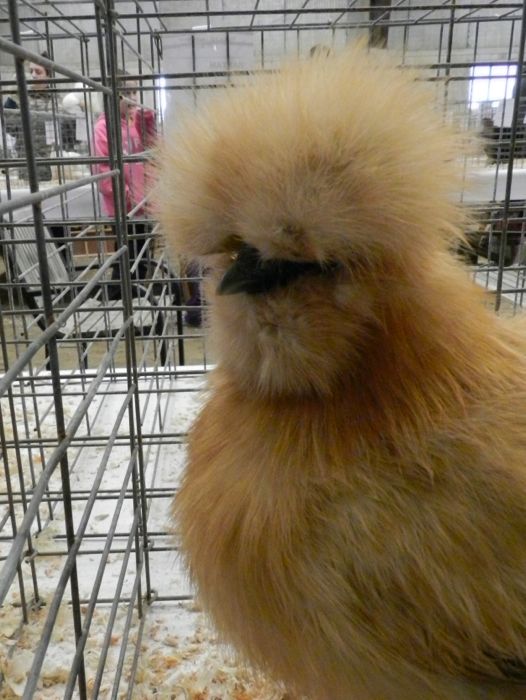
Well they didn't find non-avian dinosaur feathers until the 1990's. So we don't know everything.
Dinosaurs could have had feathers that resembled fur, like on this bird. You're being a little too closed minded, I think.

edit on 8-12-2012 by ShotGunRum because: (no reason given)
Would it not be possible that the larger dinosaurs that had feathers, perhaps they were not so used so much as sexual displays as they surmise because
they can't fly with them.
But, what if the feathers helped them to be lighter on their feet as they ran, they would run, spread their non-flight wings and create enough lift to make themselves run faster?
Eventually through natural selection, they would evolve the feathers and bodies to a point where they would actually start to lift off.
But, what if the feathers helped them to be lighter on their feet as they ran, they would run, spread their non-flight wings and create enough lift to make themselves run faster?
Eventually through natural selection, they would evolve the feathers and bodies to a point where they would actually start to lift off.
reply to post by Toadmund
That's an interesting theory. Ostriches run with their wings open to balance.
www.animalcorner.co.uk...
animals.jrank.org...
That's an interesting theory. Ostriches run with their wings open to balance.
Ostriches have small wings that are covered with fluffy feathers. The wings are too small to lift the Ostriches heavy bodies off the ground and into the air but are used as rudders when the bird is running to help it change direction.
www.animalcorner.co.uk...
animals.jrank.org...
edit on 8-12-2012 by ShotGunRum because: (no reason
given)
Interesting read, its a shame to think that we may never know what they were really like and that we may be stuck with our dated impressions.
These vides by Jack Horner are worth a watch, he looks at the way our knowledge of dinosaurs is distorted by scientific egos wanting to find bigger and better species of dinosaurs, disregarding the evidence that they may be the same as previously known species. The second video talks about some of the discoveries hes made trying to extract dinosaur DNA and how to build a dinosaur from a chicken!
www.ted.com...
www.ted.com...
These vides by Jack Horner are worth a watch, he looks at the way our knowledge of dinosaurs is distorted by scientific egos wanting to find bigger and better species of dinosaurs, disregarding the evidence that they may be the same as previously known species. The second video talks about some of the discoveries hes made trying to extract dinosaur DNA and how to build a dinosaur from a chicken!
www.ted.com...
www.ted.com...
Thank you! This is the sort of thought provoking thread that makes ATS so wonderful. T-Rex was so cute when he was sleeping.
new topics
-
RIP Merrily Harpur British Big Cat Realist
Cryptozoology: 1 hours ago -
Australian mercenary caught and crying as he is a prisoner of war.
Other Current Events: 7 hours ago -
JILL BIDEN Wants JOE to Punish Democrats Who Forced Him to Leave Office in Disgrace on 1.20.2025.
2024 Elections: 8 hours ago -
Panamanian President-“every square meter” of the Panama Canal belongs to Panama.
New World Order: 8 hours ago -
NYPD arrests migrant who allegedly set woman on fire on subway train, watched her burn to death
Breaking Alternative News: 11 hours ago
top topics
-
California Business Owners Blindsided by Surprise Payroll Taxes
US Political Madness: 16 hours ago, 20 flags -
The clotting is not going away latest
Medical Issues & Conspiracies: 14 hours ago, 10 flags -
F-18 shot down over Red Sea....by our own Destroyer?
Other Current Events: 15 hours ago, 7 flags -
NYPD arrests migrant who allegedly set woman on fire on subway train, watched her burn to death
Breaking Alternative News: 11 hours ago, 7 flags -
Panamanian President-“every square meter” of the Panama Canal belongs to Panama.
New World Order: 8 hours ago, 6 flags -
Australian mercenary caught and crying as he is a prisoner of war.
Other Current Events: 7 hours ago, 6 flags -
JILL BIDEN Wants JOE to Punish Democrats Who Forced Him to Leave Office in Disgrace on 1.20.2025.
2024 Elections: 8 hours ago, 5 flags -
RIP Merrily Harpur British Big Cat Realist
Cryptozoology: 1 hours ago, 3 flags -
Chef Gerald R. Ford
Food and Cooking: 13 hours ago, 2 flags
active topics
-
The clotting is not going away latest
Medical Issues & Conspiracies • 11 • : UpIsNowDown2 -
JILL BIDEN Wants JOE to Punish Democrats Who Forced Him to Leave Office in Disgrace on 1.20.2025.
2024 Elections • 6 • : 38181 -
F-18 shot down over Red Sea....by our own Destroyer?
Other Current Events • 11 • : 38181 -
Panamanian President-“every square meter” of the Panama Canal belongs to Panama.
New World Order • 7 • : Flyingclaydisk -
Australian mercenary caught and crying as he is a prisoner of war.
Other Current Events • 5 • : Flyingclaydisk -
RIP Merrily Harpur British Big Cat Realist
Cryptozoology • 0 • : TimBurr -
‘Something horrible’: Somerset pit reveals bronze age cannibalism
Ancient & Lost Civilizations • 17 • : BrucellaOrchitis -
Why isn't Psychiatry involved?
Social Issues and Civil Unrest • 30 • : BrucellaOrchitis -
The Daily Mail trying to imply “it’s aliens”
Dissecting Disinformation • 12 • : KrustyKrab -
The Effects of Electric Fields and Plasma on Plant Growth
Science & Technology • 8 • : ChaoticOrder

